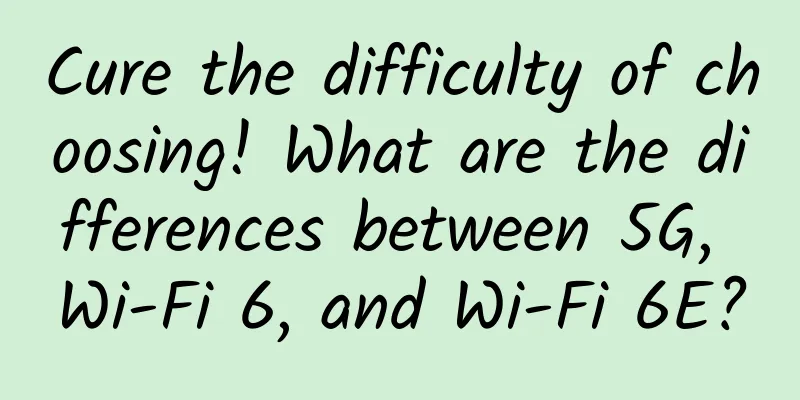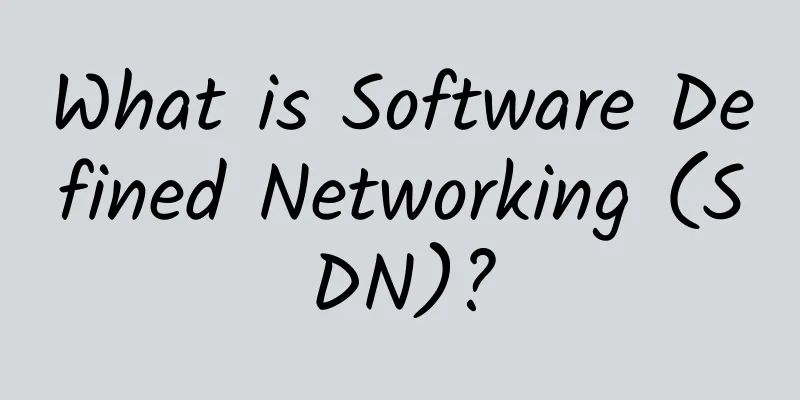Cure the difficulty of choosing! What are the differences between 5G, Wi-Fi 6, and Wi-Fi 6E?

|
This article is reprinted from the WeChat public account "Computer World", written by Zeus Kerravala. Please contact the Computer World public account for reprinting this article. Upgrade to Wi-Fi 6, Wi-Fi 6E, or 5G as appropriateIn the past, wireless networks were considered the convenience of the network, while wired networks were the ones that provided the best performance. This is no longer the case, as many mission-critical services are wireless, such as healthcare, manufacturing, and warehousing. The rise of video has put a huge strain on traditional Wi-Fi networks, which has degraded network quality. Newer wireless solutions are clearly better, but the options are confusing. Wi-Fi 6 builds on the foundation of Wi-Fi 5, but introduces many features from the cellular network world to reduce congestion, extend battery life, and extend coverage distance. Wi-Fi 6E uses the 6Ghz spectrum, which has faster access speeds and less congestion than Wi-Fi 6, but is not backward compatible with Wi-Fi 5 and earlier versions. Proprietary 5G uses standards such as CBRS (Citizens Broadband Radio Service) to enable Wi-Fi to reach cellular network speeds. None of these technologies is better than the other, as they have different uses. The general deployment model is a mix of the three, with Wi-Fi 6 used for general-purpose connections, areas with higher customer density can be enhanced with Wi-Fi 6E, and proprietary 5G will be used for mission-critical use cases, such as production workshops. ☆ Make security an inherent part of the network In the past, network technology and security technology were deployed independently, with the latter usually overlaid on the network. This is far from ideal, but it is sufficient to prevent most security incidents. Network engineers design the network, while security professionals deploy security tools at each entry point. One of the challenges today is that there are hundreds, if not thousands, of entry points, from SaaS applications to virtual tunnels to guest access on Wi-Fi networks. Even if an enterprise had unlimited money to spend, it would be impossible to deploy all the security tools to guard every entry point. Another complication is the growing number of security tools. In the past, firewalls and IDS/IPS systems were sufficient to protect enterprises. Modern security stacks include not only these systems, but also ZTNA (zero trust network access), SWG (secure web gateway), CASB (cloud access security broker), endpoint and network detection and response, and other tools. An increasingly popular way to protect enterprises is to embed security into the network as a cloud service. This is often called secure access service edge (SASE), which enables enterprises to deploy enterprise-grade security measures anywhere in the network, including employees' homes. The success of SASE depends on aligning security operations teams with network operations teams. This can be challenging, but it is essential for any enterprise that wants to modernize its network. Skill Sets for Network ProfessionalsIt is worth mentioning that today's network engineers need to become software power users because modern network equipment can be managed, configured and programmed through software APIs and developer interfaces. A few years ago, enterprises required network engineers to become developers in order to fully utilize these software systems. However, this was met with great resistance in the networking industry because most network professionals had little interest in becoming developers. In reality, network professionals don’t need to be developers, but they should be familiar with how to use software. Making an API call to perform a task is much simpler than using a command line interface, and it also greatly reduces the possibility of errors. Although network hardware has been equipped with software interfaces for many years, the adoption rate has been low. If the network is to be modernized, the skill sets of the people who run the network must also keep pace with the times. Author: Zeus Kerravala is founder and principal analyst at ZK Research. Original URL: https://www.networkworld.com/article/ 3628908/5-steps-for-modernizing-enterprise-networks.html |
<<: Accident review: We duplicated the order ID!
>>: Serverless Engineering Practice | Tips for Optimizing and Debugging Serverless Applications
Recommend
Megalayer regular VPS 50% off from 24 yuan/month, special VPS annual payment from 199 yuan, Hong Kong/Philippines/US data centers
Megalayer is offering a 50% discount promotion fo...
China Academy of Information and Communications Technology: In November, domestic 5G mobile phone shipments reached 20.136 million units, accounting for 68.1%
On December 10, the China Academy of Information ...
There is no optical communication without optical modules, is it true?
Over the past 100 years, human beings have develo...
How to solve the problem that Ubuntu 18.04 cannot start normally after switching from XEN to KVM
There are fewer and fewer businesses that still u...
Experts give reasons for slow 4G network speed: too many users and bloated apps
Do you feel that the current 4G network speed is ...
Xiaoyu Yilian's full range of new products are officially released to ignite the nuclear fusion of the audio and video conferencing industry
On August 2, the 2017 Xiaoyu Yilian E=mc² new pro...
[Hard-core literacy] What exactly is coherent optical communication?
introduction: Hello everyone, I am Xiaozaojun. In...
China Telecom faces four major challenges in network reconstruction of SDN/NFV practice
On July 11, 2016, China Telecom released the &quo...
How do weak-current system devices in different network segments communicate with each other?
As the number of employees or departments increas...
Talk about Kerberos kinit command and ccache mechanism
1. Introduction Hello everyone, I recently encoun...
Top ten trend predictions: Where will domestic telecom operators go in 2021?
After a complicated 2020, the wheel of time has e...
How 5G precision timing will change our automated world
What comes to mind when you hear the word “automa...
Seamless broadband experience: Unleashing the power of network services and infrastructure
Importance of Network Services Network services p...
Sangfor Launches SIP Falcon Edition: A Lightweight and Cost-Effective Full-Flow Threat Analysis System
In recent years, with the deepening of informatiz...
WePC: Netherlands VPS backhaul CN2/AS9929 starting at 24 yuan per month - 512MB/10G NVMe/400GB@200Mbps (limited speed upon reaching capacity)
WePC uses the .au domain name and describes itsel...









